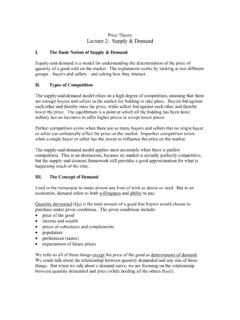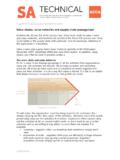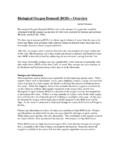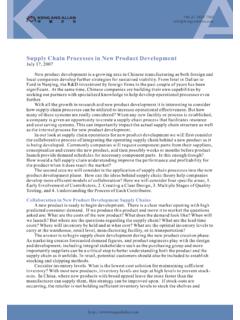Transcription of Week 3 (Case Study 1) DEMAND & SUPPLY: Wii Console
1 Week 3 ( case Study 1) DEMAND & supply : Wii Console INTRODUCTION The Wii is a video game Console made by Nintendo. It seems that this is the one of the most successful consoles made by Nintendo to date, and it is the successor to the Gamecube. The Wii is Nintendo's fifth home video game Console . The Wii is a very interesting Console , having WiFi online capabilities, wireless controllers, and blue-tooth. BACKGROUND The Wii is different than other video game consoles launched by Nintendo in the past due to many reasons, but the main one is the controller. The controller has revolutionized gaming. The controller uses a miniature gyroscope inside of it to detect its orientation, and a sensor bar attached to the Wii Console to detect where it is in 3D space. The controller can be used much like a mouse, as things on the screen can be manipulated simply by pointing and pressing a button, but instead of moving the controller on a flat surface, a person can simply point the controller at the TV much like a TV remote.
2 By this merit, the controller has become simple, and it gives game developers something new to toy with. Nintendo packaged a game with the system called Wii Sports, which features 5 different minigames: baseball, boxing, bowling, tennis, and golf, each having the player using the controller as if they were playing the actual game. For example, you would swing the remote as if it was a tennis racket in tennis. Launch On September 14, 2006, Nintendo released information for Japan, North and South America, Australia, Asia and Europe, including dates, prices, and projected unit distribution numbers. It was announced that the majority of the 2006 shipments would be allotted to the Americas. The media hype began immediately. The Wii was launched in the United States at $ on November 19, 2006, two days after the PS3 was released in North America. It was later launched in the United Kingdom on December 8, 2006 at 179.
3 The Wii was launched in South Korea on April 26, 2008 and in Taiwan on July 12, 2008. Sales The UK suffered a widespread shortage of Console units as many high-street and online stores were unable to fulfil all pre-orders by The Wii "has been a sell-out virtually everywhere in America," Fils-Aime said in an interview. "We understand the frustration of can tell you that we expect no slowdown after the first of the year. We want to say that if you could possibly hold out just a little longer, there will be more product in January." Read more: #ixzz1 UdYsVIZn Christmas 2006. Some UK stores still had a shortage of consoles by March of the next year. The market lead is largest in the Japanese market, where it currently leads in total sales, having outsold Playstation 3 and Xbox 360 by factors of 2:1 to 6:1nearly every week from launch until November 2007.
4 In 2008, the Wii was the best-selling home Console in Japan with 2,908,342 units sold. In Australia, the Wii exceeded the record set by the Xbox 360 to become the fastest-selling game Console in Australian history. In the North American market lifetime-to-date sales for the Wii have reached 30 million in the North American market alone since the Console 's launch in November 2006. DEMAND still outpaced supply in the United States as of June 2007. In October 2008, Nintendo announced that between October and December 2008 the Wii would have its North American supplies increased considerably from 2007 s levels, while producing million Wii units a month worldwide, compared to million per month in 2007. Unfortunately for consumers, it took until March 2009 (and 48 million units) to make Wii available to those who want to walk into a retail store and pick one up. Profit While Microsoft and Sony have experienced losses producing their consoles in the hopes of making a long-term profit on software sales, Nintendo reportedly has optimized production costs to obtain a significant profit margin with each Wii unit sold.
5 Nintendo reported on May 7, 2009 increases in operating profits for its fiscal year (April 1, 2008 March 31, 2009), and a rise in sales setting record earnings compared to the previous year. Price drop On September 23, 2009, Nintendo announced its first price drops for the Console . In Japan, the price dropped from 25,000 to 20,000, effective October 1, 2009. In the United States, the price was reduced to $ , effective September 27, 2009. In Europe (excepting non-eurozone nations), the price of a Wii Console dropped to 199 from 249. Nintendo sold more than three million Wii consoles in the in December 2009, setting a regional record for the month and ending 9 months of declining sales, as a result of the price cut and software releases such as New Super Mario Bros. Wii. As of the end of that month, the Wii was the best-selling home video game Console produced by Nintendo with sales of over 67 million units, surpassing that of the original Nintendo Entertainment System.
6 As of June 30, 2011, Nintendo has sold million Wii consoles. THEORIES DEMAND & supply Elasticity Shortage Surplus Equilibrium Production Further Reading/ Hyperlinks; Questions 1. Would the DEMAND for the Wii Console be relatively inelastic or relatively elastic? State why. 2. Would the supply for the Wii Console be relatively inelastic or relatively elastic? State why. 3. Draw the DEMAND and supply curves as you have described them. 4. Was the severe shortage for over two years an old marketing ploy called intentional scarcity, in which a company purposely keeps its hot product in short supply to build buzz. Or was it simply bad planning on Nintendo's part? What did this mean for households? What were the implications for Nintendo? 5. Can you suggest a reason why Nintendo dropped the price of the Wii Console in late 2009. How would you expect this to affect revenues?
7 Week 3 ( case Study 2) THE BANKING CRISIS IN IRELAND AND THE US INTRODUCTION A number of major international banks and numerous banks of lesser size in developed countries were crippled in the aftermath of the global financial crisis. Normal lending activity was impeded, while capital markets are unable or unwilling to provide the banks with sufficient equity capital to pull them out of their dire straits. Government responses have greatly differed, from straight nationalization to providing capital support in forms entailing varying degrees of shareholder dilution and intervention in management, to guaranteeing banks against potential losses on certain asset classes. In the main, the problems have been rolled over rather than resolved, despite increasing capital injections and risk exposure of governments, and there has been a great deal of uncertainty as to the real situation of banks which has impeded a return to normal functioning of the interbank and credit markets.
8 BACKGROUND In early 2007, the first major warning of a crisis came in the form of HSBC making a significant loss from their ill-timed 2002 acquisition of subprime lender Household International. It was easy for policy makers to convince themselves and the wider public that the problem was contained to subprime. However, by late 2007, these localized signs of distress turned into a global event, with losses spreading to banks in Europe (such as mortgage lender Northern Rock), and distress was no longer limited to financial institutions with exposure to the subprime mortgage market. The credit crisis resulted in mutual distrust amongst large banks operating in the global market for interbank loans which meant credit was hard to come by for many banks. While the emergence of the US crisis was evident from mid-2007 as mortgage defaults began to gather pace, the Irish crisis did not manifest itself until a year later.
9 Ireland did not feel the full force of the turmoil until the collapse of Lehman Brothers sent shock waves through international financial markets. One of the main differences between the US and Irish crises is the troubled assets behind them. The US credit-liquidity crisis followed a period of rapid financial innovation, during which many complex new products were introduced. The risk profile of the interlinked US financial markets were not properly understood by regulators and participants. In contrast, the Irish crisis evolved from a traditional TIMELINE OF FINANCIAL CRISIS Feb 07 HSBC losses Oct 07 Merill Lynch losses Mar 08 Collapse of Bear Stearns Sept 08 Lehman Brothers bankrupt Sept 08 Irish Government Guarantee Sept 08 Fannie Mae and Freddie Mac Sept 08 AIG Bailout Sept 08 TARP established Oct 08 CPP Jan 09 Anglo Nationalized Jan 09 Recapitalization of AIB, BoI April 09 NAMA Nov 10 EU/IMF deal credit boom and bust.
10 Irish domestic financial institutions availed of cheap short-term funds using Euro-denominated bonds and interbank borrowing from Euro-area banks. Domestic property developers took advantage of the availability of excessive credit leading to the Irish banks loan books being poorly diversified. As Connor (2010) pointed out there appears to be four common deep causal factors in the periods leading up to both the US and the Irish crisis. Irrational Exuberance In both countries this irrational exuberance grew during unusually benign economic climates, the Great Moderation period in the USA and the Celtic Tiger period in Ireland leading to asset price bubbles. Capital Bonanza Very low real borrowing rates sustained by international capital inflows into both countries. Regulatory Imprudence in response to political pressure by special interests (but different types of political pressures serving different special interests in the two countries).




